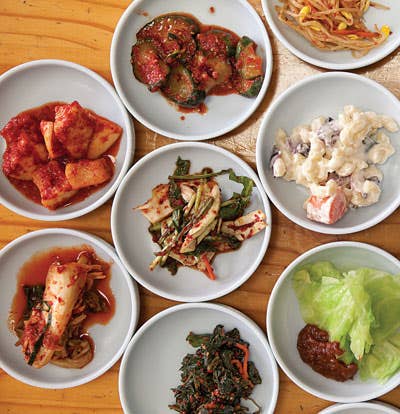
Banchan
You know how torn you can get trying to decide what to order at a restaurant? Well, at a Korean place, that's never a problem, because no matter what your main dish is, you get to round it out with half a dozen or so small, shared side dishes, called banchan. Like those pictured here, at Mapo Kkak Doo Gee restaurant in Los Angeles, banchan can include anything from pickled vegetables to braised turnips to American-style macaroni salad. As a half-Korean kid growing up in North Carolina and Alabama, I ate most of my banchan at home. My mother was born in South Korea, and she expressed her love for her family by feeding us until we couldn't eat another bite. She'd get up early to start making the banchan, and when it came time to eat, she'd portion them out on small white plates. My siblings and I would often help her, and as we cooked, my mother would remind us that, in Korea, people didn't have as much food as most Americans did. Still, they made delicious banchan with whatever meat or vegetables they had, with the simplest of ingredients and spices. I have memories of sitting on the linoleum floor in our old house as Mom made one of my favorite banchan, called yukwe, raw flank steak marinated in sesame oil and crushed garlic—a Korean version of beef tartar. But the most famous banchan, hands down, is kimchi, not just the fermented-cabbage kind but also lightly marinated ones, made with bean sprouts, cucumbers, and other vegetables. Some kimchis have more bite or spice than other banchan, but that's the point. A single banchan isn't meant to be eaten alone; it's a way of balancing the many tastes and textures in a Korean meal. It's part of a whole. —Johnathan Frye, Montgomery, Alabama
Keep Reading
Continue to Next Story










